8.1: Chapter 16- Physical Development in Middle Childhood
- Page ID
- 55305
\( \newcommand{\vecs}[1]{\overset { \scriptstyle \rightharpoonup} {\mathbf{#1}} } \)
\( \newcommand{\vecd}[1]{\overset{-\!-\!\rightharpoonup}{\vphantom{a}\smash {#1}}} \)
\( \newcommand{\id}{\mathrm{id}}\) \( \newcommand{\Span}{\mathrm{span}}\)
( \newcommand{\kernel}{\mathrm{null}\,}\) \( \newcommand{\range}{\mathrm{range}\,}\)
\( \newcommand{\RealPart}{\mathrm{Re}}\) \( \newcommand{\ImaginaryPart}{\mathrm{Im}}\)
\( \newcommand{\Argument}{\mathrm{Arg}}\) \( \newcommand{\norm}[1]{\| #1 \|}\)
\( \newcommand{\inner}[2]{\langle #1, #2 \rangle}\)
\( \newcommand{\Span}{\mathrm{span}}\)
\( \newcommand{\id}{\mathrm{id}}\)
\( \newcommand{\Span}{\mathrm{span}}\)
\( \newcommand{\kernel}{\mathrm{null}\,}\)
\( \newcommand{\range}{\mathrm{range}\,}\)
\( \newcommand{\RealPart}{\mathrm{Re}}\)
\( \newcommand{\ImaginaryPart}{\mathrm{Im}}\)
\( \newcommand{\Argument}{\mathrm{Arg}}\)
\( \newcommand{\norm}[1]{\| #1 \|}\)
\( \newcommand{\inner}[2]{\langle #1, #2 \rangle}\)
\( \newcommand{\Span}{\mathrm{span}}\) \( \newcommand{\AA}{\unicode[.8,0]{x212B}}\)
\( \newcommand{\vectorA}[1]{\vec{#1}} % arrow\)
\( \newcommand{\vectorAt}[1]{\vec{\text{#1}}} % arrow\)
\( \newcommand{\vectorB}[1]{\overset { \scriptstyle \rightharpoonup} {\mathbf{#1}} } \)
\( \newcommand{\vectorC}[1]{\textbf{#1}} \)
\( \newcommand{\vectorD}[1]{\overrightarrow{#1}} \)
\( \newcommand{\vectorDt}[1]{\overrightarrow{\text{#1}}} \)
\( \newcommand{\vectE}[1]{\overset{-\!-\!\rightharpoonup}{\vphantom{a}\smash{\mathbf {#1}}}} \)
\( \newcommand{\vecs}[1]{\overset { \scriptstyle \rightharpoonup} {\mathbf{#1}} } \)
\( \newcommand{\vecd}[1]{\overset{-\!-\!\rightharpoonup}{\vphantom{a}\smash {#1}}} \)
\(\newcommand{\avec}{\mathbf a}\) \(\newcommand{\bvec}{\mathbf b}\) \(\newcommand{\cvec}{\mathbf c}\) \(\newcommand{\dvec}{\mathbf d}\) \(\newcommand{\dtil}{\widetilde{\mathbf d}}\) \(\newcommand{\evec}{\mathbf e}\) \(\newcommand{\fvec}{\mathbf f}\) \(\newcommand{\nvec}{\mathbf n}\) \(\newcommand{\pvec}{\mathbf p}\) \(\newcommand{\qvec}{\mathbf q}\) \(\newcommand{\svec}{\mathbf s}\) \(\newcommand{\tvec}{\mathbf t}\) \(\newcommand{\uvec}{\mathbf u}\) \(\newcommand{\vvec}{\mathbf v}\) \(\newcommand{\wvec}{\mathbf w}\) \(\newcommand{\xvec}{\mathbf x}\) \(\newcommand{\yvec}{\mathbf y}\) \(\newcommand{\zvec}{\mathbf z}\) \(\newcommand{\rvec}{\mathbf r}\) \(\newcommand{\mvec}{\mathbf m}\) \(\newcommand{\zerovec}{\mathbf 0}\) \(\newcommand{\onevec}{\mathbf 1}\) \(\newcommand{\real}{\mathbb R}\) \(\newcommand{\twovec}[2]{\left[\begin{array}{r}#1 \\ #2 \end{array}\right]}\) \(\newcommand{\ctwovec}[2]{\left[\begin{array}{c}#1 \\ #2 \end{array}\right]}\) \(\newcommand{\threevec}[3]{\left[\begin{array}{r}#1 \\ #2 \\ #3 \end{array}\right]}\) \(\newcommand{\cthreevec}[3]{\left[\begin{array}{c}#1 \\ #2 \\ #3 \end{array}\right]}\) \(\newcommand{\fourvec}[4]{\left[\begin{array}{r}#1 \\ #2 \\ #3 \\ #4 \end{array}\right]}\) \(\newcommand{\cfourvec}[4]{\left[\begin{array}{c}#1 \\ #2 \\ #3 \\ #4 \end{array}\right]}\) \(\newcommand{\fivevec}[5]{\left[\begin{array}{r}#1 \\ #2 \\ #3 \\ #4 \\ #5 \\ \end{array}\right]}\) \(\newcommand{\cfivevec}[5]{\left[\begin{array}{c}#1 \\ #2 \\ #3 \\ #4 \\ #5 \\ \end{array}\right]}\) \(\newcommand{\mattwo}[4]{\left[\begin{array}{rr}#1 \amp #2 \\ #3 \amp #4 \\ \end{array}\right]}\) \(\newcommand{\laspan}[1]{\text{Span}\{#1\}}\) \(\newcommand{\bcal}{\cal B}\) \(\newcommand{\ccal}{\cal C}\) \(\newcommand{\scal}{\cal S}\) \(\newcommand{\wcal}{\cal W}\) \(\newcommand{\ecal}{\cal E}\) \(\newcommand{\coords}[2]{\left\{#1\right\}_{#2}}\) \(\newcommand{\gray}[1]{\color{gray}{#1}}\) \(\newcommand{\lgray}[1]{\color{lightgray}{#1}}\) \(\newcommand{\rank}{\operatorname{rank}}\) \(\newcommand{\row}{\text{Row}}\) \(\newcommand{\col}{\text{Col}}\) \(\renewcommand{\row}{\text{Row}}\) \(\newcommand{\nul}{\text{Nul}}\) \(\newcommand{\var}{\text{Var}}\) \(\newcommand{\corr}{\text{corr}}\) \(\newcommand{\len}[1]{\left|#1\right|}\) \(\newcommand{\bbar}{\overline{\bvec}}\) \(\newcommand{\bhat}{\widehat{\bvec}}\) \(\newcommand{\bperp}{\bvec^\perp}\) \(\newcommand{\xhat}{\widehat{\xvec}}\) \(\newcommand{\vhat}{\widehat{\vvec}}\) \(\newcommand{\uhat}{\widehat{\uvec}}\) \(\newcommand{\what}{\widehat{\wvec}}\) \(\newcommand{\Sighat}{\widehat{\Sigma}}\) \(\newcommand{\lt}{<}\) \(\newcommand{\gt}{>}\) \(\newcommand{\amp}{&}\) \(\definecolor{fillinmathshade}{gray}{0.9}\)Chapter 16 Learning Objectives
- Summarize the overall physical growth
- Describe the changes in brain maturation
- Describe the positive effects of sports
- Describe reasons for a lack of participation in youth sports
- Explain current trends regarding being overweight in childhood, the negative consequences of excess weight, the lack of recognition of being overweight, and interventions to normalize weight
Overall Physical Growth: Rates of growth generally slow during these years. Typically, a child will gain about 5-7 pounds a year and grow about 2-3 inches per year (CDC, 2000). They also tend to slim down and gain muscle strength and lung capacity making it possible to engage in strenuous physical activity for long periods of time. The beginning of the growth spurt, which occurs prior to puberty, begins two years earlier for females than males. The mean age for the beginning of the growth spurt for girls is nine, while for boys it is eleven. Children of this age tend to sharpen their abilities to perform both gross motor skills, such as riding a bike, and fine motor skills, such as cutting their fingernails. In gross motor skills (involving large muscles) boys typically outperform girls, while with fine motor skills (small muscles) girls outperform the boys. These improvements in motor skills are related to brain growth and experience during this developmental period.
Brain Growth: Two major brain growth spurts occur during middle/late childhood (Spreen, Riser, & Edgell, 1995). Between ages 6 and 8, significant improvements in fine motor skills and eye-hand coordination are noted. Then between 10 and 12 years of age, the frontal lobes become more developed and improvements in logic, planning, and memory are evident (van der Molen & Molenaar, 1994). Myelination is one factor responsible for these growths. From age 6 to 12, the nerve cells in the association areas of the brain, that is those areas where sensory, motor, and intellectual functioning connect, become almost completely myelinated (Johnson, 2005). This myelination contributes to increases in information processing speed and the child’s reaction time. The hippocampus, responsible for transferring information from the short-term to long- term memory, also show increases in myelination resulting in improvements in memory functioning (Rolls, 2000). Children in middle to late childhood are also better able to plan, coordinate activity using both left and right hemispheres of the brain, and to control emotional outbursts. Paying attention is also improved as the prefrontal cortex matures (Markant & Thomas, 2013).
Sports
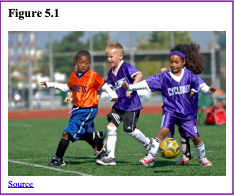
children. The U. S. Soccer Federation recently advised coaches to reduce the amount of drilling engaged in during practice and to allow children to play more freely and to choose their own positions. The hope is that this will build on their love of the game and foster their natural talents.
- Higher levels of satisfaction with family and overall quality of life in children
- Improved physical and emotional development
- Better academic performance
Figure 5.2
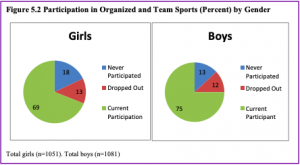
Figure 5.3 Percent of Students Participating in Organized Sports, by Gender, Race, and Ethnicity
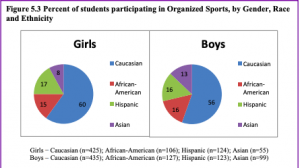
Finally, Sabo and Veliz asked children who had dropped out of organized sports why they left. For both girls and boys, the number one answer was that it was no longer any fun (see Table 5.1). According to the Sport Policy and Research Collaborative (SPARC) (2013), almost 1 in 3 children drop out of organized sports, and while there are many factors involved in the decisions to drop out, one suggestion has been the lack of training that coaches of children’s sports receive may be contributing to this attrition (Barnett, Smoll & Smith, 1992). Several studies have found that when coaches receive proper training, the drop-out rate is about 5% instead of the usual 30% (Fraser-Thomas, Côté , & Deakin, 2005; SPARC, 2013).
Table 5.1 Top Reasons Dropped Out or Stopped Playing Organized/Team Sports
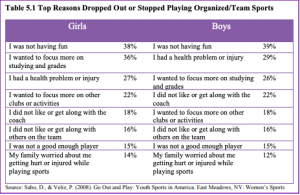
Welcome to the world of esports: According to Discover Esports (2017), esports is a form of competition with the medium being video games. Players use computers or specific video game consoles to play video games against each other. In addition to playing themselves, children my just watch others play the video games. The recent SPARC (2016) report on the “State of Play” in the United States highlights a disturbing trend. One in four children between the ages of 5 and 16 rate playing computer games with their friends as a form of exercise. Over half of males and about 20% of females, aged 12-19, say they are fans of esports.
Physical Education: For many children, physical education in school is a key component in introducing children to sports. After years of schools cutting back on physical education programs, there has been a turn around, prompted by concerns over childhood obesity and the related health issues. Despite these changes, currently only the state of Oregon and the District of Columbia meet PE guidelines of a minimum of 150 minutes per week of physical activity in elementary school and 225 minutes in middle school (SPARC, 2016).
Childhood Obesity
harmful substances that can impair its functioning. Another important executive functioning skill is controlling impulses and delaying gratification. Children who are overweight show less inhibitory control than normal weight children, which may make it more difficult for them to avoid unhealthy foods (Lu, 2016). Overall, being overweight as a child increases the risk for cognitive decline as one ages.
Figure 5.4 Being Overweight can be a Lifelong Struggle
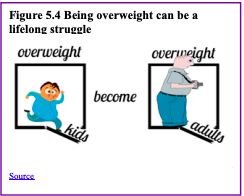
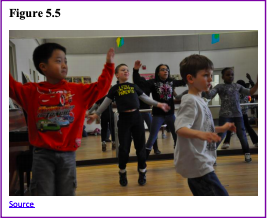
children (Lu, 2016). Parents should take caution against emphasizing diet alone to avoid the development of any obsession about dieting that can lead to eating disorders. Instead, increasing a child’s activity level is most helpful.
References
Aiken, L. R. (1994). Psychological testing and assessment (8th ed.). Needham Heights, MA: Allyn and Bacon.
Alloway, T. P. (2009). Working memory, but not IQ, predicts subsequent learning in children with learning difficulties. European Journal of Psychological Assessment, 25, 92-98.
Alloway, T. P., Bibile, V., & Lau, G. (2013). Computerized working memory training: Can lead to gains in cognitive skills in students? Computers in Human Behavior, 29, 632-638.
American Civil Liberties Union (2016). Overview of lesbian and gay parenting, adoption and foster care. Retrieved from https://www.aclu.org/fact-sheet/over...nd-foster-care
American Psychiatric Association. (2013). Diagnostic and statistical manual of mental disorders (5th ed.). Washington, DC: American Psychiatric Association.
American Speech-Language and Hearing Association. (2016). Voice disorders. Retrieved from http://www.asha.org/PracticePortal/C...ice-Disorders/ Arditti, J. A. (1999). Rethinking relationships between divorced mothers and their children: Capitalizing on family strengths. Family Relations, 48, 109-119.
Anderson, J. (2018). The impact of family structure on the health of children: Effects of divorce. The Linacre Quarterly 81(4), 378–387.
Arkowicz, H., & Lilienfeld. (2013). Is divorce bad for children? Scientific American Mind, 24(1), 68-69. Figure 5.27 206
Asher, S. R., & Hymel, S. (1981). Children’s social competence in peer relations: Sociometric and behavioral assessment. In J. K. Wine & M. D. Smye (Eds.), Social competence (pp. 125-157). New York: Guilford Press.
Banaschewski, T., Becker, K., Döpfner, M., Holtmann, M., Rösler, M., & Romanos, M. (2017). Attention-deficit/hyperactivity disorder. A current overview. Deutsches Ärzteblatt International, 114, 149-159.
Bandura, A. (1977). Self-efficacy: Toward a unifying theory of behavioral change. Psychological Review, 84, 191-215.
Bandura, A. (1986). Social foundations of thought and action: A social cognitive theory. Englewood Cliffs, NJ: Prentice Hall.
Bandura, A. (1997). Self-efficacy: The exercise of control. New York: Freeman.
Barnett, N. P., Smoll, F. L., & Smith, R. E. (1992). Effects of enhancing coach-athlete relationships on youth sport attrition. The Sport Psychologist, 6, 111-127.
Barbaresi, W. J., Colligan, R. C., Weaver, A. L., Voigt, R. G., Killian, J. M., & Katusic, S. K. (2013). Mortality, ADHD, and psychosocial adversity in adults with childhood ADHD: A prospective study. Pediatrics, 131, 637–644.
Barkley, R. A. (2006). Attention-deficit hyperactivity disorder: A handbook for diagnosis and treatment. New York, NY: Guilford Press.
Barkley, R. A., Fischer, M., Smallish, L., & Fletcher, K. (2002). The persistence of attention-deficit/hyperactivity disorder into young adulthood as a function of reporting source and definition of disorder. Journal of Abnormal Psychology, 111, 279–289.
Beaulieu, C. (2004). Intercultural study of personal space: A case study. Journal of Applied Social Psychology, 34(4), 794-805.
Berk, L. (2007). Development through the life span (4th ed.). Boston: Allyn and Bacon. Berger, K. S. (2014). The developing person: Through the life span. NY: Worth Publishers.
Bigelow, B. J. (1977). Children’s friendship expectations: A cognitive developmental study. Child Development, 48, 246–253.
Bigelow, B. J., & La Gaipa, J. J. (1975). Children’s written descriptions of friendship: A multidimensional analysis. Developmental Psychology, 11(6), 857-858.
Binet, A., Simon, T., & Town, C. H. (1915). A method of measuring the development of the intelligence of young children (3rd ed.) Chicago, IL: Chicago Medical Book.
Bink, M. L., & Marsh, R. L. (2000). Cognitive regularities in creative activity. Review of General Psychology, 4(1), 59–78.
Bjorklund, D. F. (2005). Children’s thinking: Developmental function and individual differences (4th ed.). Belmont, CA: Wadsworth.
Black, J. A., Park, M., Gregson, J. (2015). Child obesity cut-offs as derived from parental perceptions: Cross-sectional questionnaire. British Journal of General Practice, 65, e234-e239.
Boulton, M. J. (1999). Concurrent and longitudinal relations between children’s playground behavior and social preference, victimization, and bullying. Child Development, 70, 944-954.
Brody, N. (2003). Construct validation of the Sternberg Triarchic Abilities Test: Comment and reanalysis. Intelligence, 31(4), 319–329.
Bronfenbrenner, U. (1979). The ecology of human development: Experiments by nature and design. Cambridge, MA: Harvard Univeristy Press.
Brown, S. L. (2000). Union transitions among cohabitors: The significance of relationship assessments and expectations. Journal of Marriage and the Family, 62, 833-846. 207
Bruning, R. H., Schraw, G. J., Norby, M. M., & Ronning, R. R. (2004). Cognitive psychology and instruction. Upper Saddle River, NJ: Pearson.
Burt, S. A. (2009). Rethinking environmental contributions to child and adolescent psychopathology: A meta-analysis of shared environmental influences. Psychological Bulletin, 135, 608–637.
Carlson, N. (2013). Physiology of behavior. Upper Saddle River, NJ: Pearson Education.
Carlson, S. M., & Zelazo, P. D., & Faja, S. (2013). Executive function. In P. D. Zelazo (Ed.), The Oxford handbook of developmental psychology, Vol. 1: Body and mind (pp. 706-743). New York: Oxford University Press
Camarota, S. A., & Zeigler, K. (2015). One in five U. S. residents speaks foreign language at home. Retrieved from https://cis.org/sites/default/files/...anguage-15.pdf
Cazden, C. (2001). Classroom discourse, (2nd ed.). Portsmouth, NH: Heineman Publishers.
Centers for Disease Control and Prevention. (2000). 2000 CDC growth charts for the United States: Methods and development. Retrieved from http://www.cdc.gov/nchs/data/series/...1/sr11_246.pdf
Centers for Disease Control and Prevention. (2010, November 12). Increasing prevalence of parent reported attentiondeficit/hyperactivity disorder among children, United States, 2003–2007. Morbidity and Mortality Weekly Report, 59(44), 1439–1443.
Centers for Disease Control and Prevention. (2014). Birth defects. Retrieved from https://www.cdc.gov/ncbddd/birthdefe...rome/data.html
Chao, R. (2001). Extending research on the consequences of parenting styles for Chinese Americans and European Americans. Child Development, 72, 1832-1843.
Cillesen, A. H., & Mayeaux, L. (2004). From censure to reinforcement: Developmental changes in the association between aggression and social status. Child Development, 75, 147-163.
Clark, M. L., & Bittle, M. L. (1992). Friendship expectations and the evaluation of present friendships in middle childhood and early adolescence. Child Study Journal, 22, 115–135.
Clay, R. A. (2013). Psychologists are using research-backed behavioral interventions that effectively treat children with ADHD. Monitor on Psychology, 44(2), 45-47.
Cohen, E. (2004). Teaching cooperative learning: The challenge for teacher education. Albany, NY: State University of New York Press.
Colangelo, N., & Assouline, S. (2009). Acceleration: Meeting the academic and social needs of students. In T. Balchin, B. Hymer, & D. J. Matthews (Eds.), The Routledge international companion to gifted education (pp. 194–202). New York, NY: Routledge.
Cowan, R., & Powell, D. (2014). The contributions of domain-general and numerical factors to third-grade arithmetic skills and mathematical learning disability. Journal of Educational Psychology, 106, 214-229.
Crain, W. (2005). Theories of development (5th ed.). Upper Saddle River, NJ: Pearson.
Davidson, T. L. (2014). Do impaired memory and body weight regulation originate in childhood with diet-induced hippocampal dysfunction? The American Journal of Clinical Nutrition, 99(5), 971-972.
Davidson, T. L., Hargrave, S. L., Swithers, S. E., Sample, C. H., Fu, X., Kinzig, K. P., & Zheng, W. (2013). Inter-relationships among diet, obesity, and hippocampal-dependent cognitive function. Neuroscience, 253, 110-122.
de Ribaupierre, A. (2002). Working memory and attentional processes across the lifespan. In P. Graf & N. Ohta (Eds.), Lifespan of development of human memory (pp. 59-80). Cambridge, MA: The MIT Press. 208
Discover Esports. (2017). What are esports? Retrieved from https://discoveresports.com/what-are-esports/
Doolen, J., Alpert, P. T. and Miller, S. K. (2009), Parental disconnect between perceived and actual weight status of children: A metasynthesis of the current research. Journal of the American Academy of Nurse Practitioners, 21, 160–166. doi:10.1111/j.1745-7599.2008.00382.x
Drexler, P. (2005). Raising boys without men. Emmaus, PA: Rodale.
Dutton, E., van der Linden, D., Lynn, R. (2016). The negative Flynn effect: A systematic literature review. Intelligence, 59, 163- 169. Ennis, R. H. (1987). A taxonomy of critical thinking dispositions and abilities. In J. Baron & R. Sternberg (Eds.), Teaching thinking skills: Theory and practice (pp. 9-26). New York: Freeman.
Ericsson, K. (1998). The scientific study of expert levels of performance: General implications for optimal learning and creativity. High Ability Studies, 9(1), 75–100.
Erikson, E. (1982). The life cycle completed. NY: Norton & Company.
Flynn, J. R. (1999). Searching for justice: The discovery of IQ gains over time. American Psychologist, 54(1), 5–20.
Francis, N. (2006). The development of secondary discourse ability and metalinguistic awareness in second language learners. International Journal of Applied Linguistics, 16, 37-47.
Fraser-Thomas, J. L., Côté, J., & Deakin, J. (2005). Youth sport programs: An avenue to foster positive youth development. Physical Education & Sport Pedagogy, 10, 19-40.
Furnham, A., & Bachtiar, V. (2008). Personality and intelligence as predictors of creativity. Personality and Individual Differences, 45(7), 613–617.
Furstenberg, F. F., & Cherlin, A. J. (1991). Divided families: What happens to children when parents part. Cambridge, MA: Harvard University Press.
Gardner, H. (1983). Frames of mind: The theory of multiple intelligences. New York: Basic Books.
Gardner, H. (1999). Intelligence reframed: Multiple intelligences for the 21st century. New York, NY: Basic Books.
Gilligan, C. (1982). In a different voice: Psychological theory and women’s development. Cambridge, MA: Harvard University Press.
Gizer, I. R., Ficks, C., & Waldman, I. D. (2009). Candidate gene studies of ADHD: A meta-analytic review. Human Genetics, 126, 51–90.
Gottfredson, L. S. (1997). Mainstream science on intelligence: An editorial with 52 signatories, history and bibliography. Intelligence, 24(1), 13–23.
Gottfredson, L. S. (2003). Dissecting practical intelligence theory: Its claims and evidence. Intelligence, 31(4), 343–397.
Greenspan, S., Loughlin, G., & Black, R. S. (2001). Credulity and gullibility in people with developmental disorders: A framework for future research. In L. M. Glidden (Ed.), Internationalreview ofresearch in mental retardation (Vol. 24, pp. 101–135). San Diego, CA: Academic Press.
Guttmann, J. (1993). Divorce in psychosocial perspective: Theory and research. Hillsdale, NJ: L. Erlbaum Associates.
Haidt, J. (2001). The emotional dog and its rational tail: A social intuitionist approach to moral judgment. Psychological Review, 108(4), 814–834.
Hales, C.M., Carroll, M.D., Fryar, C.D., & Ogden, C.L. (2017). Prevalence of obesity among adults and youth: United States, 2015–2016. NCHS data brief, no 288. Hyattsville, MD: National Center for Health Statistics. 209
Halpern, D. F. (1992). Sex differences in cognitive abilities (2nd ed.). Hillsdale, NJ: Lawrence Erlbaum Associates.
Hansen, L., Umeda, Y., & McKinney, M. (2002). Savings in the relearning of second language vocabulary: The effects of time and proficiency. Language Learning, 52, 653-663.
Hartup, W. W. (1983). Adolescents and their friends. New Directions for Child and Adolescent Development, 60, 3-22.
Hennessey, B. A., & Amabile, T. M. (2010). Creativity. Annual Review of Psychology, 61, 569–598.
Hetherington, E. M., & Kelly, J. (2002). For better or for worse: Divorce reconsidered. New York: W.W. Norton.
Horvat, E. M. (2004). Moments of social inclusion and exclusion: Race, class, and cultural capital in family-school relationships. In A. Lareau (Author) & J. H. Ballantine & J. Z. Spade (Eds.), Schools and society: A sociological approach to education (2nd ed., pp. 276-286). Belmont, CA: Wadsworth.
Hoza, B., Mrug, S., Gerdes, A. C., Hinshaw, S. P., Bukowski, W. M., Gold, J. A., . . . Arnold, L. E. (2005). What aspects of peer relationships are impaired in children with ADHD? Journal of Consulting and Clinical Psychology, 73, 411–423.
Inhelder, B., & Piaget, J. (1958). The growth of logical thinking from childhood to adolescence. New York: Basic Books.
Jaffee, S., & Hyde, J. S. (2000). Gender differences in moral orientation: A meta-analysis. Psychological Bulletin, 126(5), 703– 726.
Jimenez, R., Garcia, G., & Pearson. D. (1995). Three children, two languages, and strategic reading: Case studies in bilingual/monolingual reading. American Educational Research Journal, 32 (1), 67-97. Johnson, D., & Johnson, R. (1998). Learning together and alone: Cooperative, competitive, and individualistic learning, (5th ed.). Boston: Allyn & Bacon.
Johnson, M. (2005). Developmental neuroscience, psychophysiology, and genetics. In M. Bornstein & M. Lamb (Eds.), Developmental science: An advanced textbook (5th ed., pp. 187-222).
Hillsdale, NJ: Erlbaum. Johnson, W., Carothers, A., & Deary, I. J. (2009). A role for the X chromosome in sex differences in variability in general intelligence? Perspectives on Psychological Science, 4(6), 598–611.
Kail, R. V., McBride-Chang, C., Ferrer, E., Cho, J.R., & Shu, H. (2013). Cultural differences in the development of processing speed. Developmental Science, 16, 476-483.
Katz, D. L. (2015). Oblivobesity: Looking over the overweight that parents keep overlooking. Childhood Obesity, 11(3), 225- 226.
Klein, R. G., Mannuzza, S., Olazagasti, M. A. R., Roizen, E., Hutchison, J. A., Lashua, E. C., & Castellanos, F. X. (2012). Clinical and functional outcome of childhood attention-deficit/hyperactivity disorder 33 years later. Archives of General Psychiatry, 69, 1295–1303.
Klima, T., & Repetti, R. L. (2008). Children’s peer relations and their psychological adjustment: Differences between close friends and the larger peer group. Merrill-Palmer Quarterly, 54, 151-178.
Kohlberg, L. (1963). The development of children’s orientations toward a moral order: Sequence in the development of moral thought. Vita Humana, 16, 11-36.
Kohlberg, L. (1984). The psychology of moral development: Essays on moral development (Vol. 2, p. 200). San Francisco, CA: Harper & Row.
Kohnert, K., Yim, D., Nett, K., Kan, P., & Duran, L. (2005). Intervention with linguistically diverse preschool children. Language, Speech, and Hearing Services in Schools, 36, 251-263.
Lally, M. J., & Valentine-French, S. J. (2018). Introduction to Psychology [Adapted from Charles Stangor, Introduction to Psychology] Grayslake, IL: College of Lake County. 210
Liang, J., Matheson, B., Kaye, W., & Boutelle, K. (2014). Neurocognitive correlates of obesity and obesity-related behaviors in children and adolescents. International Journal of Obesity, 38(4), 494-506
Linnet, K. M., Dalsgaard, S., Obel, C., Wisborg, K., Henriksen, T. B., Rodriquez, A., . . . Jarvelin, M. R.(2003). Maternal lifestyle factors in pregnancy risk of attention deficit hyperactivity disorder and associated behaviors: A review of current evidence. The American Journal of Psychiatry, 160, 1028–1040.
Livingston, G. (2018). About one-third of U.S. children are living with an unmarried parent. Retrieved from www.pewresearch.org/fact-tan...marriedparent/
Loe, I. M., & Feldman, H. M. (2007). Academic and educational outcomes of children with ADHD. Journal of Pediatric Psychology, 32, 643–654.
Lofquist, D. (2011). Same-sex households. Current population reports, ACSBR/10-03. U.S. CensusBureau, Washington, DC. Retrieved from www.census.gov/prod/2011pubs/acsbr10-03.pdf
Lu, S. (2016). Obesity and the growing brain. Monitor on Psychology, 47(6), 40-43.
Lubinski, D., & Benbow, C. P. (2006). Study of mathematically precocious youth after 35 years: Uncovering antecedents for the development of math-science expertise. Perspectives on Psychological Science, 1(4), 316–345.
Macbeth, D. (2003). Hugh Mehan’s Learning Lessons reconsidered: On the differences between naturalistic and critical analysis of classroom discourse. American Educational Research Journal, 40 (1), 239-280.
Markant, J. C., & Thomas, K. M. (2013). Postnatal brain development. In P. D. Zelazo (Ed.), Oxford handbook of developmental psychology. New York: Oxford University Press.
Marshal, M. P., & Molina, B. S. G. (2006). Antisocial behaviors moderate the deviant peer pathway to substance use in children with ADHD. Journal of Clinical Child and Adolescent Psychology, 35, 216–226.
McCann, D., Barrett, A., Cooper, A., Crumpler, D., Dalen, L., Grimshaw, K., . . . Stevenson, J. (2007). Food additives and hyperactive behaviour in 3-year-old and 8/9-year-old children in the community: A randomised, double-blinded, placebo-controlled trial. The Lancet, 370(9598), 1560–1567.
McGuine, T. A. (2016). The association of sports specialization and history of lower extremity injury in high school athletes. Medical Science in Sports and Exercise, 45 (supplement 5), 866.
McLanahan, S., & Sandefur, G. D. (1994). Growing up with a single parent: What hurts, what helps. Cambridge, MA: Harvard University Press.
Medline Plus. (2016a). Phonological disorder. National Institute of Mental Health: U.S. National Library of Medicine. Retrieved from https://medlineplus.gov/ency/article/001541.htm
Medline Plus. (2016b). Speech and communication disorders. National Institute of Mental Health: U.S. National Library of Medicine. Retrieved from https://medlineplus.gov/speechandcom...disorders.html
Medline Plus. (2016c). Stuttering. National Institute of Mental Health: U.S. National Library of Medicine. Retrieved from https://medlineplus.gov/ency/article/001427.htm
Miller, P. H. (2000). How best to utilize a deficiency? Child Development, 71, 1013-1017.
Minami, M. (2002). Culture-specific language styles: The development of oral narrative and literacy. Clevedon, UK: Multilingual Matters.
National Center for Learning Disabilities. (2017). The state of LD: Understanding the 1 in 5. Retrieved from https://www.ncld.org/archives/blog/t...ing-the-1-in-5
National Institute of Neurological Disorders and Stroke. (2016). Dyslexia information page. Retrieved from https://www.ninds.nih.gov/Disorders/...formation-Page 211
National Institute on Deafness and other Communication Disorders. (2016). Stuttering. Retrieved from https://www.nidcd.nih.gov/health/stuttering
Neisser, U. (1997). Rising scores on intelligence tests. American Scientist, 85, 440-447.
Neisser, U. (1998). The rising curve. Washington, DC: American Psychological Association.
Oude Luttikhuis, H., Stolk, R. and Sauer, P. (2010), How do parents of 4- to 5-year-old children perceive the weight of their children? Acta Pædiatrica, 99, 263–267. doi:10.1111/j.1651-2227.2009.01576.x
Patterson, C. J. (2013). Children of lesbian and gay parents: Psychology, law, and Policy. Psychology of Sexual Orientation and Gender Diversity, 1, 27-34.
Pettit, G. S., Clawson, M. A., Dodge, K. A., & Bates, J. E. (1996). Stability and change in peer-rejected status: The role of child behavior, parenting, and family ecology. Merrill-Palmer Quarterly, 42(2), 267-294.
Pew Research Center. (2010). New family types. Retrieved from www.pewsocialtrends.org/2010/...w-familytypes/
Pew Research Center. (2015). Parenting in America. Retrieved from www.pewresearch.org/wpconten...rica_FINAL.pdf
Plante, I., De la Sablonnière, R., Aronson, J. M., & Théorêt, M. (2013). Gender stereotype endorsement and achievement-related outcomes: The role of competence beliefs and task values. Contemporary Educational Psychology, 38(3), 225-235.
PreBler, A., Krajewski, K., & Hasselhorn, M. (2013). Working memory capacity in preschool children contributes to the acquisition of school relevant precursor skills. Learning and Individual Differences, 23, 138-144.
Public Law 93-112, 87 Stat. 394 (Sept. 26, 1973). Rehabilitation Act of 1973. Washington, D.C.: United States Government Printing Office.
Public Law 101-336, 104 Stat. 327 (July 26, 1990). Americans with Disabilities Act of 1990. Washington, D.C.: United States Government Printing Office.
Public Law 108-446, 118 Stat. 2647 (December 3, 2004). Individuals with Disabilities Education Improvement Act. Washington, D.C.: United States Government Printing Office.
Reid, S. (2017). 4 questions for Mitch Prinstein. Monitor on Psychology, 48(8), 31-32.
Rest, J. (1979). Development in judging moral issues. Minneapolis: University of Minnesota Press.
Retelsdorf, J., Asbrock, F., & Schwartz, K. (2015). “Michael can’t read!” teachers’ gender stereotypes and boys’ reading selfconcept. Journal of Educational Psychology, 107, 186-194.
Richter, D, & Lemola, S. (2017). Growing up with a single mother and life satisfaction in adulthood: A test of mediating and moderating factors. PLOS ONE 12(6): e0179639. Retrieved from https://journals.plos.org/plosone/ar...l.pone.0179639
Rogers, R., Malancharuvil-Berkes, E., Mosely, M., Hui, D., & O’Garro, G. (2005). Critical discourse analysis in education: A review of the literature. Review of Educational Research, 75 (3), 365-416.
Rogoff, B. (2003). The culture of human development. New York: Oxford University Press.
Rolls, E. (2000). Memory systems in the brain. Annual Review of Psychology, 51, 599-630.
Ross, H. S., & Lollis, S. P. (1989). A social relations analysis of toddler peer relations. Child Development, 60, 1082-1091.
Rubin, R. (1980). Children’s friendships. Cambridge, MA: Harvard University Press.
Sabo, D., & Veliz, P. (2008). Go out and play: Youth sports in America. East Meadow, NY: Women’s Sports Foundation 212
Sarafrazi, N., Hughes, J. P., & Borrud, L. (2014). Perception of weight status in U.S. children and adolescents aged 8-15 years, 2005-2012. NCHS Data Brief, 158, 1-8.
Schneider, W., Kron-Sperl, V., & Hünnerkopf, M. (2009). The development of young children’s memory strategies: Evidence from the Würzburg Longitudinal Memory Study. European Journal of Developmental Psychology, 6, 70-99.
Schneider, W., & Pressley, M. (1997). Memory development between 2 and 20. Hillsdale, NJ: Lawrence Erlbaum Associates, Inc.
Schwartz, D., Lansford, J. E., Dodge, K. A., Pettit, G. S., & Bates, J. E. (2014). Peer victimization during middle childhood as a lead indicator of internalizing problems and diagnostic outcomes in late adolescence. Journal of Clinical Child and Adolescent Psychology, 44, 393-404.
Seagoe, M. V. (1975). Terman and the gifted. Los Altos, CA: William Kaufmann.
Seccombe, K., & Warner, R. L. (2004). Marriages and families: Relationships in social context. Belmont, CA: Wadsworth/Thomson Learning.
Seifert, K. (2011). Educational psychology. Houston, TX: Rice University.
Selman, Robert L. (1980). The growth of interpersonal understanding. London: Academic Press.
Siegler, R. S. (1992). The other Alfred Binet. Developmental Psychology, 28(2), 179–190.
Simonton, D. K. (1992). The social context of career success and course for 2,026 scientists and inventors. Personality and Social Psychology Bulletin, 18(4), 452–463.
Simonton, D. K. (2000). Creativity: Cognitive, personal, developmental, and social aspects. American Psychologist, 55(1), 151– 158.
Sodian, B., & Schneider, W. (1999). Memory strategy development: Gradual increase, sudden insight or roller coaster? In F. E. Weinert & W. Schneider (Eds.), Individual development from 3 to 12: Findings from the Munich Longitudinal Study (pp. 61-77). Cambridge, UK: Cambridge University Press.
Sourander, A., Sucksdorff, M., Chudal, R, Surcel, H., Hinkka-Yli-Salomäki, S., Gyllenberg, D., Cheslack-Postava, K., & Brown, A. (2019). Prenatal cotinine levels and ADHD among offspring. Pediatrics, 143(3), e20183144.
Sport Policy and Research Collaborative (SPARC, 2013). What is the status of youth coach training in the U.S.? University of Florida. Retrieved from assets.aspeninstitute.org/co...0Brief%20Coach ing%20Education%20–%20FINAL.pdf
Sport Policy and Research Collaborative (SPARC, 2016). State of play 2016: Trends and developments. The Aspen Institute. Retrieved from https://www.aspeninstitute.org/publi...-developments/
Spreen, O., Rissser, A., & Edgell, D. (1995). Developmental neuropsychology. New York: Oxford University Press.
Sternberg, R. J. (1985). Beyond IQ: A triarchic theory of human intelligence. New York, NY: Cambridge University Press.
Sternberg, R. J. (2003). Contemporary theories of intelligence. In W. M. Reynolds & G. E. Miller (Eds.), Handbook of psychology: Educational psychology (Vol. 7, pp. 23–45). Hoboken, NJ: John Wiley & Sons.
Sternberg, R. J., Wagner, R. K., & Okagaki, L. (1993). Practical intelligence: The nature and role of tacit knowledge in work and at school. In J. M. Puckett & H. W. Reese (Eds.), Mechanisms of everyday cognition (pp. 205–227). Hillsdale, NJ: Lawrence Erlbaum Associates.
Stewart, A. J., Copeland, Chester, Malley, & Barenbaum. (1997). Separating together: How divorce transforms families. New York: Guilford Press.
Stewart, S. M. & Bond, M. H. (2002), A critical look at parenting research from the mainstream: Problems uncovered while adapting Western research to non-Western cultures. British Journal of Developmental Psychology, 20, 379–392. doi:10.1348/026151002320620389 213
Stopbullying.gov. (2018). Preventing weight-based bullying. Retrieved from https://www.stopbullying.gov/blog/20...-bullying.html
Swanson, J. M., Kinsbourne, M., Nigg, J., Lamphear, B., Stefanatos, G. A., Volkow, N., …& Wadhwa, P. D. (2007). Etiologic subtypes of attention-deficit/hyperactivity disorder: brain imaging, molecular genetic and environmental factors and the dopamine hypothesis. Neuropsychological Review, 17(1), 39-59.
Tarasova, I. V., Volf, N. V., & Razoumnikova, O. M. (2010). Parameters of cortical interactions in subjects with high and low levels of verbal creativity. Human Physiology, 36(1), 80–85.
Terman, L. M., & Oden, M. H. (1959). Genetic studies of genius: The gifted group at mid-life (Vol. 5). Stanford, CA: Stanford University Press.
Thakur, G. A., Sengupta, S. M., Grizenko, N., Schmitz, N., Page, V., & Joober, R. (2013). Maternal smoking during pregnancy and ADHD: A comprehensive clinical and neurocognitive characterization. Nicotine and Tobacco Research, 15, 149– 157.
Tharp, R. & Gallimore, R. (1989). Rousing minds to life. New York: Cambridge University Press.
Thompson, A., Molina, B. S. G., Pelham, W., & Gnagy, E. M. (2007). Risky driving in adolescents and young adults with childhood ADHD. Journal of Pediatric Psychology, 32, 745–759.
Torres-Guzman, M. (1998). Language culture, and literacy in Puerto Rican communities. In B. Perez (Ed.), Sociocultural contexts of language and literacy. Mahwah, NJ: Erlbaum.
Treffert, D. A., & Wallace, G. L. (2004). Islands of genius. Scientific American, 14–23. Retrieved from gordonresearch.com/articles_a..._of_Genius.pdf
Tse, L. (2001). Why don’t they learn English? New York: Teachers’ College Press.
Turiel, E. (1998). The development of morality. In W. Damon (Ed.), Handbook of child psychology: Socialization (5th ed., Vol. 3, pp. 863–932). New York, NY: John Wiley & Sons.
United States Department of Education. (2017). Every Student Succeeds Act (ESSA). Retrieved from https://www.ed.gov/essa?src=ft United States Youth Soccer. (2012).
US youth soccer at a glance. Retrieved from http://www.usyouthsoccer.org/media_kit/ataglance/
Vakil, E., Blachstein, H., Sheinman, M., & Greenstein, Y. (2009). Developmental changes in attention tests norms: Implications for the structure of attention. Child Neuropsychology, 15, 21-39.
van der Molen, M., & Molenaar, P. (1994). Cognitive psychophysiology: A window to cognitive development and brain maturation. In G. Dawson & K. Fischer (Eds.), Human behavior and the developing brain. New York: Guilford.
Visher, E. B., & Visher, J. S. (1985). Stepfamilies are different. Journal of Family Therapy, 7(1), 9-18.
Volkow N. D., Fowler J. S., Logan J., Alexoff D., Zhu W., Telang F., . . . Apelskog-Torres K. (2009). Effects of modafinil on dopamine and dopamine transporters in the male human brain: Clinical implications. Journal of the American Medical Association, 301, 1148–1154.
Wagner, R., & Sternberg, R. (1985). Practical intelligence in real-world pursuits: The role of tacit knowledge. Journal of Personality and Social Psychology, 49(2), 436–458.
Watkins, C. E., Campbell, V. L., Nieberding, R., & Hallmark, R. (1995). Contemporary practice of psychological assessment by clinical psychologists. Professional Psychology: Research and Practice, 26(1), 54–60.
Weaver, J. M., & Schofield, T. J. (2015). Mediation and moderation of divorce effects on children’s behavior problems. Journal of Family Psychology, 29(1), 39-48. doi:dx.doi.org/10.1037/fam0000043 214
Weir, K. (2019). Family-based behavioral treatment is key to addressing childhood obesity. Monitor on Pscyhology, 50(4), 31- 35.
Weisberg, R. (2006). Creativity: Understanding innovation in problem solving, science, invention, and the arts. Hoboken, NJ: John Wiley & Sons.
Wilens, E., Fararone, S.V., Biederman, J., & Gunawardene, S. (2003). Does the treatment of Attention-deficit/hyperactivity disorder with stimulants contribute to use/abuse? Pediatrics, 111(1), 97-109.
Wolraich, M. L., Wilson, D. B., & White, J. W. (1995). The effect of sugar on behavior or cognition in children. Journal of the American Medical Association, 274, 1617–1621.
Attribution
Lifespan Development: A Psychological Perspective Second Edition by Martha Lally and Suzanne Valentine-French under the Creative Commons Attribution-Noncommercial-Share Alike 3.0 unported license.


